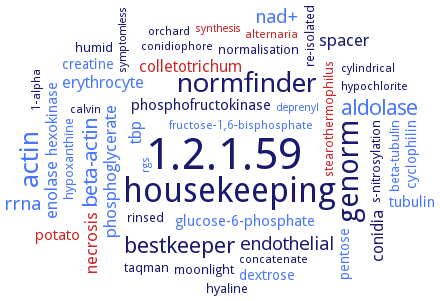1.2.1.59: glyceraldehyde-3-phosphate dehydrogenase (NAD(P)+) (phosphorylating)
This is an abbreviated version!
For detailed information about glyceraldehyde-3-phosphate dehydrogenase (NAD(P)+) (phosphorylating), go to the full flat file.

Word Map on EC 1.2.1.59 
-
1.2.1.59
-
housekeeping
-
genorm
-
normfinder
-
actin
-
bestkeeper
-
aldolase
-
beta-actin
-
nad+
-
rrna
-
endothelial
-
phosphoglycerate
-
necrosis
-
enolase
-
spacer
-
erythrocyte
-
conidia
-
colletotrichum
-
tbp
-
tubulin
-
phosphofructokinase
-
hexokinase
-
glucose-6-phosphate
-
potato
-
cyclophilin
-
dextrose
-
creatine
-
pentose
-
stearothermophilus
-
moonlight
-
humid
-
hyaline
-
taqman
-
beta-tubulin
-
re-isolated
-
s-nitrosylation
-
normalisation
-
hypoxanthine
-
rinsed
-
orchard
-
rgs
-
fructose-1,6-bisphosphate
-
calvin
-
alternaria
-
hypochlorite
-
conidiophore
-
concatenate
-
cylindrical
-
1-alpha
-
synthesis
-
symptomless
-
deprenyl
- 1.2.1.59
-
housekeeping
-
genorm
-
normfinder
- actin
-
bestkeeper
- aldolase
- beta-actin
- nad+
- rrna
- endothelial
- phosphoglycerate
- necrosis
- enolase
-
spacer
- erythrocyte
- conidia
- colletotrichum
- tbp
- tubulin
-
phosphofructokinase
- hexokinase
- glucose-6-phosphate
- potato
- cyclophilin
- dextrose
- creatine
- pentose
- stearothermophilus
-
moonlight
-
humid
-
hyaline
-
taqman
- beta-tubulin
-
re-isolated
-
s-nitrosylation
-
normalisation
- hypoxanthine
-
rinsed
-
orchard
- rgs
- fructose-1,6-bisphosphate
-
calvin
- alternaria
-
hypochlorite
-
conidiophore
-
concatenate
-
cylindrical
-
1-alpha
- synthesis
-
symptomless
- deprenyl
Reaction
Synonyms
cgap, chloroplast glyceraldehyde-3-phosphate dehydrogenase, CjGAPDH, Dehydrogenase, glyceraldehyde phosphate (nicotinamide adenine dinucleotide (phosphate)), GAP, GapA, GapB, GAPC, GAPDH, GAPDH2, GBS GAPDH, glyceraldehyde 3-phosphate dehydrogenase, glyceraldehyde-3-phosphate dehydrogenase, Glyceraldehyde-3-phosphate dehydrogenase (NAD(P)), NAD(NADP)-dependent glyceraldehyde-3-phosphate dehydrogenase, NAD(P)-dependent G3P dehydrogenase, NAD(P)-dependent glyceraldehyde-3-phosphate dehydrogenase, NADP-dependent glyceraldehyde 3-phosphate dehydrogenase, NADP-dependent glyceraldehyde-3-phosphate dehydrogenase, NADP-dependent glyceraldehydephosphate dehydrogenase, pcal_0632, phosphorylating glyceraldehyde-3-phosphate dehydrogenase, STK_13560, Triosephosphate dehydrogenase (NAD(P)), Tsac_2486


 results (
results ( results (
results ( top
top






